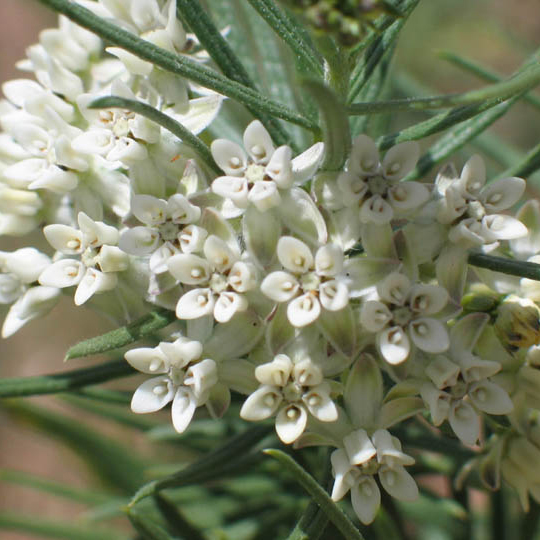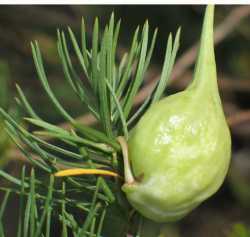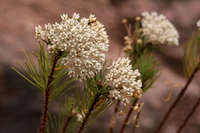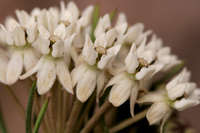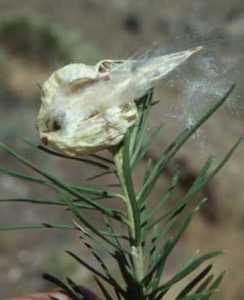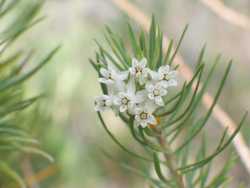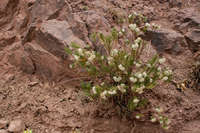- Home
- Search
- Images
- Datasets
- Sample Use
- How to Cite
- Additional Information
- About NEON
- NEON Data Portal
- ASU Biocollections
- About Symbiota
|
|
|
|
Family: Apocynaceae
pineneedle milkweed
|
Plant: Shrubs or suffrutescent perennials, 30-150 cm tall; stems erect or ascending, branching, bearing numerous raised leaf scars below, pubescent at least on leafy, younger growth; milky sap Leaves: spirally approximate, crowded, sessile, narrowly linear, resembling pine needles, the margins revolute, 1-6 cm long, ca. 1 mm broad, mostly with a few scattered hairs INFLORESCENCE: UMBELS subterminal or lateral at several of the upper nodes, 2-4 cm broad, the peduncles 0.5-2 cm long Flowers: small; calyx lobes 2-3 mm long; corolla white and typically pink- or purple-tipped outside, the lobes ca. 4-5 mm long; hoods drying yellow brown, erect or ascending, ovoid, oblong-quadrate in the lower half, narrowed in the middle on the inner face to an attenuate, rounded tip, (2.6-)3-3.6(-4) mm long, 1-1.4 mm broad in the middle, ca. 1-2 mm longer than the gynostegium, the horns attached to about the middle of the hoods, the free portion 0.5-1 mm long, radially flat or subdigitate, erect, scarcely exserted to about the same height as the gynostegium; anther wings 1-1.2 mm long; corpusculum ca. 0.25 mm long, the pollinia ca. 0.8 mm long Fruit: FOLLICLES erect or ascending on deflexed pedicels, 3-6 cm long Misc: Rocky slopes and canyons, mts; 800-1750 m (2600-5800 ft); Feb-Dec REFERENCES: Sundell, Eric. 1994. Asclepiadaceae. J. Ariz. - Nev. Acad. Sci. Volume 27, 169-187. Sundell 1993, Woodson 1954, Kearney and Peebles 1969, McDougall 1973, Nabhan et al 2015 Duration: Perennial Nativity: Native Lifeform: Subshrub General: Shrubby or suffrutescent perennials, with twiggy stems to 150 cm tall, erect to ascending, branching, usually with numerous leaf scars below; herbage puberulent to pubescent, especially on younger growth; plants with milky sap. Leaves: Alternate or appearing whorled, sessile, crowded on the stem, rigid, narrowly linear with revolute margins, resembling pine needles, usually more than 3 times as long as wide, 1-6 cm long and to 1 mm wide. Flowers: Small and white but usually pink or purple tipped on the outside, in subterminal and lateral umbels, 2-4 cm, with 10+ flowers per umbel, on peduncles to 2 cm; corolla lobes 4-5 mm long, commonly reflexed in anthesis; hood not arched at apex and hood tips rounded and not recurved, with a horn-like protrusion; horns attached to about the middle of the hoods, the free portion 0.5-1 mm long, radially flat or subdigitate, erect, scarcely exserted to about the same height as the gynostegium; calyx lobes 2-3 mm long. Fruits: Erect follicles 4-5 cm long, 1-2 cm across, lanceolate or fusiform, on deflexed or recurved pedicels. Ecology: Found on dry, rocky slopes and mesas, in canyons, and oak pine juniper woodlands from 1,000-6,000 ft (305-1829 m); flowering February-December. Distribution: s AZ and extreme s CA, south throughout the Mexican Highlands and the Transvolcanic belt. Notes: The needle-like appearance of the leaves is a dead giveaway, but you can also identify this species by the puberulent, reddish stems, the hoods without recurved tips, not arching at the apex, and the widened, triangular anther wings. The plants are unlike any other milkweed species and small individuals are commonly confused with juvenile pine trees. Known to be used as a monarch host plant but only occasionally, likely due to its high toxicity and milkiness. Ethnobotany: There is no specific use recorded but other species in the genus have uses. Etymology: Asclepias is named for the Greek God of healing Asklepios, while linaria likely means linear, parallel-sided, referring to the leaf shape. Synonyms: Asclepias filiformis, Asclepias pinifolia Editor: LCrumbacher 2011, SBuckley 2014, FSCoburn 2015, AHazelton 2015 |
|
|
|


